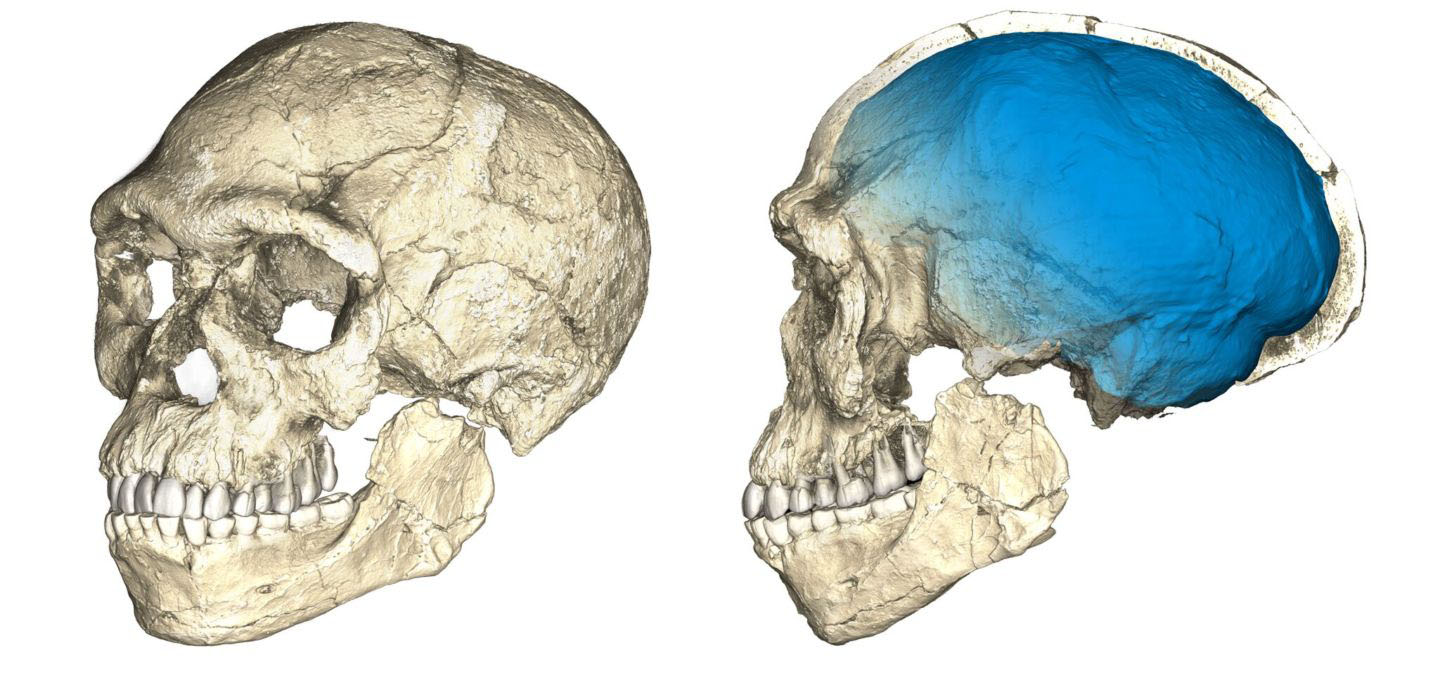
The first humans
Made in Morocco
Modern mankind is approximately 100,000 years older than we previously thought.
That is the conclusion reached by Jean-Jacques Hublin at the Max Planck Institute. He discovered the oldest Homo sapiens fossils so far, in Morocco.
The bones make short work of the reigning theory that modern man came into being rather suddenly 200,000 years ago in Ethiopia.
DNA analysis suggests that early modern man dates back as far as 500,000 years.
Cognitive abilities do not make people immune to evolutionary developments.
Reading time: 7 minutes (761 words)
‘There is no Garden of Eden in Africa’, research leader Jean-Jacques Hublin at the Max Planck Institute told several media outlets. ‘The Garden of Eden is Africa.’ Hublin based his proclamation on the discovery of human bones in Jebel lrhoud, a cave west of the Moroccan city of Marrakech.
But how surprising is his conclusion really? The assumption that the entirety of modern mankind, in all its diversity, sprung from one single well is really much more out there.
It appears that Moroccan Homo sapiens had a primitive skull and a small, soft face, not unlike present-day man. That is part of the reason the scientists think it concerns an early version of ‘us’. But for now, these so far oldest fossilised Homo sapiens bone fragments have actually led to more questions than they answer. The fact that these bones were discovered in Morocco is not even all that surprising. But the conclusion that mankind is older than we previously thought might mean that the history books have to be rewritten.
Arrogance
The discoveries and developments of the past few years are casting a shadow of doubt on the ingrained ideas about where human beings come from, according to RUG archaeologist Hans Peeters. ‘It’s a bit weird to treat evolution as some kind of linear result, as though evolution had a purpose’, he says. ‘That’s kind of a peculiar story. After all, we don’t do that for other living organisms.’
Maybe it is due to human arrogance: perhaps we think that somehow, we are above evolution. Perhaps we think that human evolution happened differently than that of other species. After all, no other species is capable of shooting rockets out into the universe or coming up with other technical marvels, such as the internet. But cognitive abilities do not make us immune to evolution, says Peeters: ‘Like any other species, mankind is subject to evolutionary developments.’
Researchers have found bones in Jebellrhoud as far back as 1968, but those were placed in a much later time period. Scientists then did not have access to the technology we have now. For example, back then people determined the age of bones on the basis of flint tools that were found near the fossils.
But Moroccan Homo sapiens made those tools in a fashion similar to that of the Neanderthals, who made them much later, and in Europe. That is why the conclusion at the time was that the fossils belonged to some sort of African Neanderthal. ‘In order to be able to make an object out of stone, you have to have three-dimensional thinking skills’, Peeters explains. ‘You have to be able to start working with a particular goal in mind, and not lose sight of that goal as you work.’ It was not until 40,000 years ago that the Homo sapiens brought flint tools to Europe. Only then did European Neanderthals start using them.
Surprising
It is probable that Homo sapiens developed even earlier. DNA analysis shows that modern man split from other known human species approximately 500,000 years ago. Up until now, there were no fossils to prove this genetic analysis. But the findings in Jebel lrhoud do prove that modern man existed earlier than other fossils have been able to show so far.
‘Paleoanthropologists always want to label and categorise fossils’, according to Peeters. ‘But the difference is in the details. But when you label fossils and erase their individual characteristics, those details are lost.’ According to the archaeologist, we should get rid of all the labels and theories and analyse only the materials themselves, using the modern techniques at our disposal. He thinks this method might lead to entirely new and surprising insights.
One thing at least is clear: the history of how modern mankind came into being is much more complex than we previously thought or perhaps even hoped, says Peeters. ‘If you compare the enormous jungle of human species that walked the earth approximately 200,000 years ago to the genetic background of modern man, you can only conclude that those species intermingled’, according to Peeters. To be clear, we are talking about at least six different human species here. ‘New findings and new interpretations over the coming years will only make the puzzle more complicated.’

